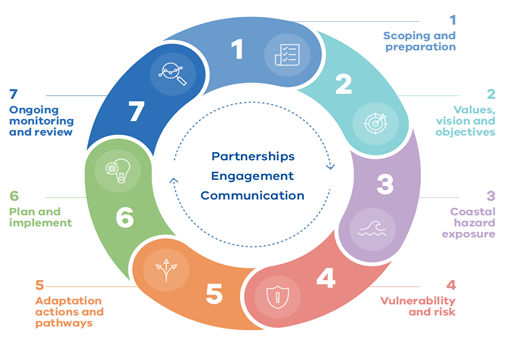
Coastal hazards
Victoria has over 2,500 km of coastline, including extensive sandy beach systems, rocky coasts, bays, inlets and estuaries, coastal lakes and floodplains. These diverse bio-cultural landscapes have been nurtured by Traditional Owners of Country for countless generations, and are dynamic environments shaped by natural coastal processes.
At times, coastal processes including erosion, inundation, and other physical/chemical processes, may have a negative impact on coastal values and uses. When this occurs, we often refer to these processes as coastal hazards.
Coastal hazard exposure occurs periodically across the coast, and is projected to increase with changes in wave action, storm activity and sea level rise associated with climate change.
A strategic approach
Victoria’s Resilient Coast – Adapting for 2100+ provides a framework, guidelines, and support for Local Government, land managers and their communities to:
- Enable place-based, best practice and long-term coastal hazard risk management and adaptation.
- Build on the directions in the Marine and Coastal Policy 2020.
In building on the Policy directions, Victoria’s Resilient Coast provides a staged approach to the technical, strategic and engagement elements of risk management and adaptation:

This approach was developed through a collaborative process, including a project partnership with Traditional Owners, and a Working Group including representatives from coastal Councils, Committees of Management, Catchment Management Authorities, government agencies, water authorities and peak body groups.
Our Victorian framework and guidelines have been informed by:
- Leading research on climate adaptation
- National / international approaches
- Victoria’s place-based adaptation needs
- The collaborative development process.
Victoria’s Resilient Coast guidelines (PDF, 15.7 MB) have been made under section 41 of the Marine and Coastal Act 2018. These guidelines must be followed when planning for, assessing, or managing coastal hazard risk under the Marine and Coastal Policy 2020.
Additional resources
Supporting technical reports are also available to support use of the guidelines:
- Coastal hazards extended guidelines (PDF, 6.8 MB), Water Technology Ltd, 2022
- Adaptation actions compendium (PDF, 7.9 MB), BMT Ltd, 2023
- An economic approach to inform adaptation (PDF, 2.3 MB), Alluvium Consulting and NCEconomics, 2022
- Adaptation pathways template guide (PDF, 4.0 MB), BMT Ltd
- Blue Carbon and Sea Country Opportunities Report (PDF, 4.4 MB), Deakin University 2023
Project timing
The collaborative development of the statewide approach was undertaken over June 2021 to July 2022.
Implementation of the framework and guidelines has commenced, with ongoing review.
Grants program
Grants are available to support eligible organisations with pilot projects, including technical, engagement and strategic planning activities aligned to one or more stages of Victoria’s Resilient Coast framework.
Please contact vicresilientcoast@delwp.vic.gov.au for further information.
Round 1 grants closed on 28 April 2022 and were awarded for the following projects:
| Project lead | Project | Victoria's Resilient Coast framework stages |
|---|---|---|
| City of Port Phillip | Port Phillip Coastal Resilience Project | 1 - 4 |
| Mornington Peninsula Shire Council | Mornington Peninsula Coastal Strategy | 1 - 4 |
| Corangamite Catchment Management Authority | Aire Valley Estuary Floodplain Project - Part 2 | 1 - 5 |
| Parks Victoria | Coastal Marine Hazard Assessment - Wilsons Promontory terrestrial and marine parks | 1 - 6 |
| Great Ocean Road Coast and Parks Authority | Anglesea Resilient 2100+ Coast Project | 1 - 6 |
| Torquay to Warrnambool Scoping Study | 1 |
Round 2 grants closed 16 March 2023 and were awarded for the following projects:
| Project lead | Project | Victoria's Resilient Coast Framework Stages |
|---|---|---|
| Barwon Coast | Bancoora Coastal Adaptation Plan | 1 - 5 |
| Bayside City Council | Dendy Street Beach Scoping Study | 1 |
| Bellarine Bayside Foreshore Committee of Management | Northern Bellarine Climate Change Coastal Adaptation Plan | 1 - 5 |
| Borough of Queenscliffe | Queenscliffe and Point Lonsdale cliff stability and beach health study | 1 - 4 |
| Frankston City Council | Frankston City Coastal Resilience 2100 | 1 - 4 |
| Gippsland Ports Committee of Management | Gippsland Ports - priority asset local coastal hazard adaptation plan | 5 |
| Glenelg Hopkins Catchment Management Authority | Distribution, health and restoration of estuarine seagrass meadows | 1 - 5 |
| Kingston City Council | Kingston Council Coastal Resilience Project | 1 - 4 |
| Parks Victoria | Point Nepean Scoping Study | 1 |
| Wilsons Promontory Coastal Hazard and Resilience Plan - additional technical assessment | 3 | |
| South Gippsland Shire Council | Venus Bay Saltmarsh Project | 1 - 4 |
| Surf Coast Shire Council | Painkalac Estuary Flood Risk Project | 1 - 5 |
Round 3 grants closed 17 November 2023 and were awarded for the following projects:
| Project lead | Project | Victoria's Resilient Coast Framework Stages |
|---|---|---|
Melbourne Water | Western Treatment Plant Coastal Hazard Assessment & Adaptation Planning Project | 3-5 |
Mornington Peninsula Shire Council | Mornington Peninsula Our Coast Our Future Coastal Strategy CHARP | 5-7 |
South Gippsland Shire Council | Waratah Bay Coastal Hazard Assessment and Adaptation Plan | 1-7 |
Bellarine Bayside | Northern Bellarine Climate Change Coastal Adaptation Plan- part 2 | 5-7 |
Glenelg Hopkins CMA | Distribution, health & restoration capacity of estuarine seagrass meadows (2) | 1-5 |
Glenelg Hopkins CMA | Estuarine Wetland Habitat Mapping Study | 1-6 |
Warrnambool City Council | Wild Coast Climate Resilience & Protection | 1-5 |
Great Ocean Road Coast and Parks Authority | Point Grey Coastal Hazard Adaptation Plan Developing a Coastal Hazard Adaptation Plan | 1-5 |
City of Greater Geelong | Point Lonsdale Hydrodynamic Modelling | 5 |
Further information and resources
If you would like to know more please email vicresilientcoast@delwp.vic.gov.au
Resources:
Victoria's Marine and Coastal Policy 2020
Page last updated: 14/05/24